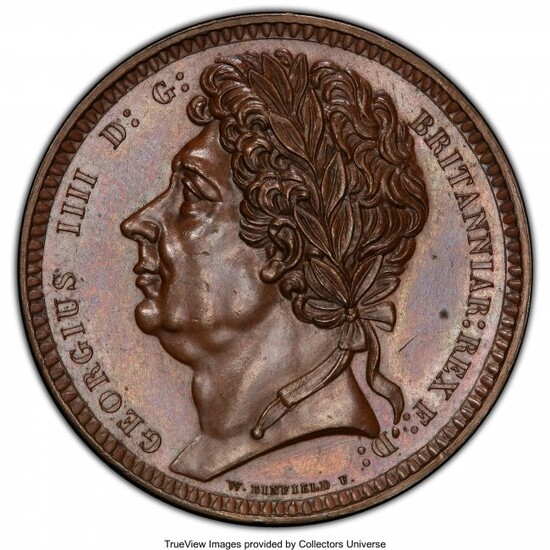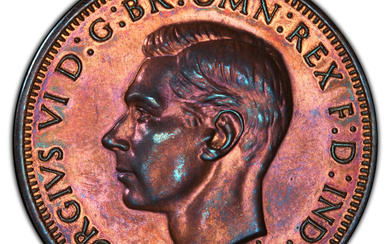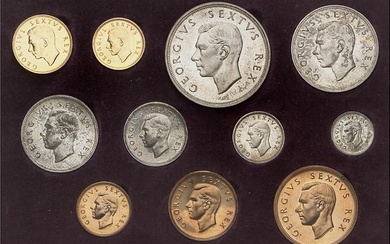31631: George IV bronze Proof Pattern 1/2 Crown ND (c.
George IV bronze Proof Pattern 1/2 Crown ND (c. 1824-1825) PR64 Brown PCGS, ESC-2393 (R6; prev. ESC-655). By W. Binfield. A pattern so rare as to be nearly unknown, with an estimated surviving population of fewer than five examples. Benedetto Pistrucci, engraver of George III's post-1816 coinage and the early designs for George IV, was asked by the King to use a marble bust by Francis Leggatt Chantre as a basis for his portrait on coinage. Pistrucci would not copy the work of another artist, and refused, leading to the discontinuation of his services in 1822 and the selection of a new engraver who would do as the King wished: William Wyon. This heralded the introduction of Wyon's "bare head" portrait of the king from 1825. However, this account omits another attempt to gain the King's favor, that of William Binfield. A medallist of the Birmingham school who was active in both London and Paris in the early 19th century, Binfield saw opportunity to demonstrate his skill and hopefully claim patronage for his engraving, as represented here through his pattern Halfcrown. Presumed to be modeled from the same bust as Wyon's portrait, this design shows a similar style to that adopted in 1825, but shows the King in a laureate wreath (a remnant from Pistrucci's portrait). The reverse is quite different from any other coinage design, bearing the value written as "2s 6d" (no value had been displayed on any Halfcrown issues since 1660) divided by a caduceus surmounted by a trident within a laureate wreath. As attractive and dynamic as the design is, it speaks more of a medal than a coin, and explains why it was not adopted and why Binfield continued his career as a medallist as opposed to a designer of coinage. In any event, this pattern is superbly engraved and exhibits immense skill, its surfaces of mahogany and burnt sienna providing a wonderful backdrop to the interesting and heavily detailed large-sized portrait of the King. Given the extreme rarity of this issue, this may be the sole opportunity to acquire an example over the course of one's lifetime, and especially an example as superb in quality as the present piece. Ex. Glendining (July 1961, Lot 172 or 173); H.M. Lingford Collection (Purchased en bloc by Baldwin's, 1951); Virgil Brand Collection; Nobleman Collection (Sotheby's March 1922, Lot 172 [part]); Murdoch Collection (Sotheby's June 1903, Lot 429 [part]); Montagu Collection (Spink 1891, Lot 996 [noted as originally accompanying lot 968 in a case bearing the Royal Arms]) HID03101062020 © 2020 Heritage Auctions | All Rights Reserved
[ translate ]View it on
Estimate
Time, Location
Auction House
George IV bronze Proof Pattern 1/2 Crown ND (c. 1824-1825) PR64 Brown PCGS, ESC-2393 (R6; prev. ESC-655). By W. Binfield. A pattern so rare as to be nearly unknown, with an estimated surviving population of fewer than five examples. Benedetto Pistrucci, engraver of George III's post-1816 coinage and the early designs for George IV, was asked by the King to use a marble bust by Francis Leggatt Chantre as a basis for his portrait on coinage. Pistrucci would not copy the work of another artist, and refused, leading to the discontinuation of his services in 1822 and the selection of a new engraver who would do as the King wished: William Wyon. This heralded the introduction of Wyon's "bare head" portrait of the king from 1825. However, this account omits another attempt to gain the King's favor, that of William Binfield. A medallist of the Birmingham school who was active in both London and Paris in the early 19th century, Binfield saw opportunity to demonstrate his skill and hopefully claim patronage for his engraving, as represented here through his pattern Halfcrown. Presumed to be modeled from the same bust as Wyon's portrait, this design shows a similar style to that adopted in 1825, but shows the King in a laureate wreath (a remnant from Pistrucci's portrait). The reverse is quite different from any other coinage design, bearing the value written as "2s 6d" (no value had been displayed on any Halfcrown issues since 1660) divided by a caduceus surmounted by a trident within a laureate wreath. As attractive and dynamic as the design is, it speaks more of a medal than a coin, and explains why it was not adopted and why Binfield continued his career as a medallist as opposed to a designer of coinage. In any event, this pattern is superbly engraved and exhibits immense skill, its surfaces of mahogany and burnt sienna providing a wonderful backdrop to the interesting and heavily detailed large-sized portrait of the King. Given the extreme rarity of this issue, this may be the sole opportunity to acquire an example over the course of one's lifetime, and especially an example as superb in quality as the present piece. Ex. Glendining (July 1961, Lot 172 or 173); H.M. Lingford Collection (Purchased en bloc by Baldwin's, 1951); Virgil Brand Collection; Nobleman Collection (Sotheby's March 1922, Lot 172 [part]); Murdoch Collection (Sotheby's June 1903, Lot 429 [part]); Montagu Collection (Spink 1891, Lot 996 [noted as originally accompanying lot 968 in a case bearing the Royal Arms]) HID03101062020 © 2020 Heritage Auctions | All Rights Reserved
[ translate ]





